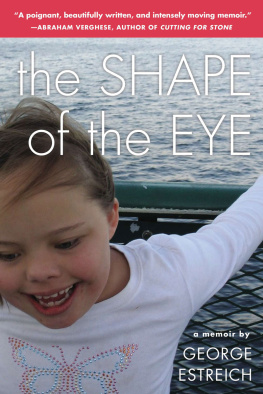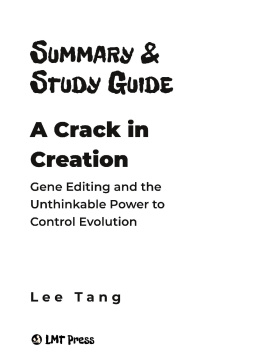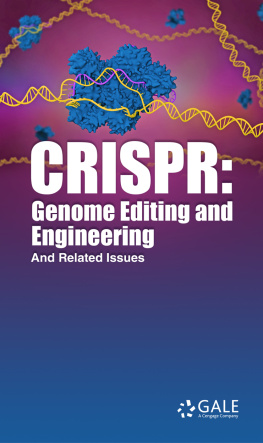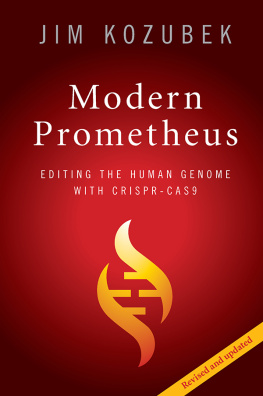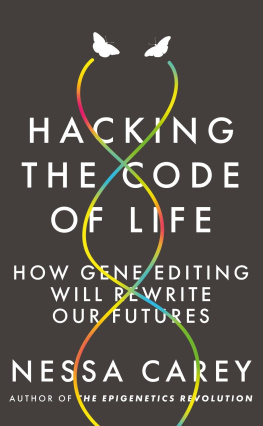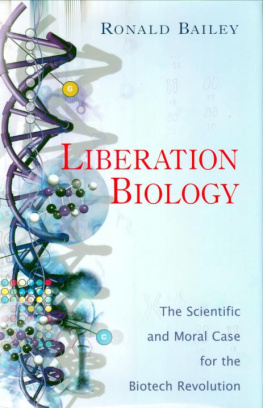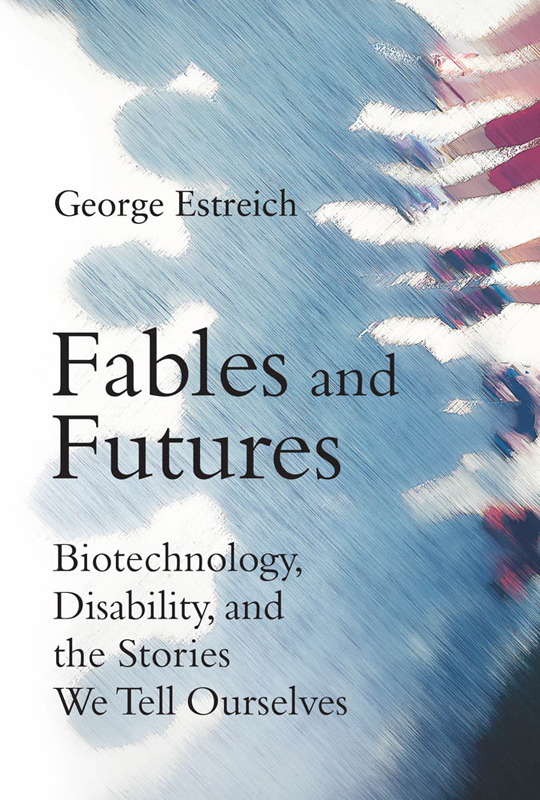Contents
Guide
Pagebreaks of the print version
Fables and Futures
Biotechnology, Disability, and the Stories We Tell Ourselves
George Estreich
The MIT Press
Cambridge, Massachusetts
London, England
2019 George Estreich
All rights reserved. No part of this book may be reproduced in any form by any electronic or mechanical means (including photocopying, recording, or information storage and retrieval) without permission in writing from the publisher.
This book was set in Stone Serif by Westchester Publishing Services. Printed and bound in the United States of America.
Library of Congress Cataloging-in-Publication Data
Names: Estreich, George, author.
Title: Fables and futures : biotechnology, disability, and the stories we tell ourselves / George Estreich.
Description: Cambridge, MA : The MIT Press, [2019] | Includes bibliographical references and index.
Identifiers: LCCN 2018027592 | ISBN 9780262039567 (hardcover : alk. paper)
Subjects: LCSH: Biotechnology. | Human genetics. | Parents of children with disabilities.
Classification: LCC TP248.2 .E83 2019 | DDC 660.6--dc23 LC record available at https://lccn.loc.gov/2018027592
d_r0
in memory of my father
Paul J. Estreich
19301996
Technology is neither good nor bad; nor is it neutral.
Melvin Kranzberg
A world where everyone is welcome is the first priority.
Marsha Saxton
Notes
Technology is neither good nor bad: Kranzberg (1986).
A world where everyone is welcome: Saxton (2017).
Contents
Introduction
In late March of 2001, a month after my younger daughter Laura was born, then diagnosed with Down syndrome, I drove out to the Oregon desert. Theresa, my wife, had taken Laura and her older sister Ellie back East, to visit family; I wanted some distance, a change of landscape. A broader perspective, or at least a new one. I was with a friend Ill call Robert, the first person I told about Laura. In the weeks since Lauras diagnosis, hed been listening more than talking; when he spoke, he was measured, considerate. He had distance without being distant. For me and Theresa, mired in simple yet unassimilable factsLauras extra chromosome, her condition, her heart defect, as yet unrepairedRoberts presence was as consoling as any empathetic shock.
We loaded up tents, packs, ramen noodles, and candy bars. Then we shooed the two dogs into the back of the Subaru: his dog, an expressive, jowly English pointer, and Penny, our anxious, submissive, cinnamon-colored mutt, fattened by years of food falling from high chairs. They scrabbled and slobbered and whined. We set out, calling back to them to calm down.
It felt good to be driving east, toward the usual limits of vision. We live in the Willamette Valley, a wide northsouth swath of agricultural grass fields, bounded to the west by the low, softened mountains of the Coast Range and to the east by the intermittent snowy peaks of the Cascades: Mount Jefferson, Three Fingered Jack, the Three Sisters, widely spaced as punctuation for an unseen sentence. As you descend from the pass, the Douglas firs recede, replaced by ponderosa pines, then juniper, then sage; the ground, once loamy, is cindery and dry; the air smells different, rarefied, sharper. Soon its all fence wire, sky, and the scoured forms of hills, their cinnamons and russets knotted by sagebrush, like the back of a rug.
As the landscape emptied out, I began talking about Laura, venting, the words spilling over. I didnt know how to think about her. I remember saying I wanted her to be Laura, my daughter, not a medical case, not an extra chromosome. I could already hear the iron doors of categories clanging shut, special needs, disabled, developmentally delayed. I didnt want her to be the sum of her medical problems. I wanted some sliver of her life left pure. Robert mostly listened and kept his counsel. I do remember his saying that Down syndrome seemed to him part of the normal range of human variation, and that, as such, Laura might be unique and valuable not in spite of her Down syndrome, but because of it.
We arrived late, switchbacking up to the plateau where the campground was, and set up tents in the shadow of rounded hills, hurrying to feed the dogs and ourselves before dark. In the evening, we walked up the dirt road from the campsite. The dogs bounded ahead, researching invisible trails.
You could still see some orange in the west. A few bright clouds were ashing over. Then the first star was out, and the sky was all gradations of blue. But one cloud stayed, pink as the inside of a grapefruit. It was different. The other clouds were, definably, volumes, objects in the sky. A child could look up and say Car, or Horse. But this one had no shape you could name by likeness. It was a blur, a region of unfocus, a mist. It was, we thought, simply higher than the other clouds, thinnest cirrus gathering the last of a sun we had already turned away from. But as the sky darkened, the clouds colors grew deeper, more saturated. It seemed lit from within. We could see the light moving, rippling with soft verticals, like folds in a heavy curtain. A dark coruscation, a pulse.
It was clear that we were looking, somehow, at the aurora borealis: a rare event at this latitude, but evidently there. The cloud was not a cloud. It had been right in front of us all along, but expectation had kept us from seeing it for what it was.
* * *
I was trying to answer the question that disability had posed. I was doing so in a world that abounds with wrong answers, that did not even have satisfactory language with which to begin to speak.
This book explores our ongoing American conversation about human-focused biotechnology: applications able to read and write DNA, the molecule of which genes are composed. If I begin with a story about Laura, its not only because her condition is genetic; its because stories about disability are central to that conversation. Even as I drove out to the desert, I was beginning to understand the shape of the standard story, to understand how much of it I had already inhaled and made my own. I was discovering the fables I already believed. In the years afterward, as I worked on a book about Laura, I learned and relearned the obvious but vital truth that narrative questions are also political ones: who gets a story, who gets to tell it, whose stories are credited, and the limits of stories themselves.
In March of 2001, I was submerged in shock, but my approximate understanding of DNA and chromosomes had improved. DNA is the long, double-stranded molecule necessary for life. It contains the instructions to build, maintain, and replicate an organism. DNAs structure, the familiar double helix, is unchanging, but the sequence of its paired component basesadenine, thymine, guanine, and cytosine, abbreviated A, T, G, and Cis variable: differences in life-forms (plane trees, rhinoceroses, E. coli, semi-employed writers) begin as differences in sequence. Significant stretches of sequence are called genes, which mainly encode the complex structures called proteins, on which life depends. Humans have between 20,000 and 25,000 genes, though these constitute only a fraction of the total DNA we inherit, which is called the genome. In humans, the long thread of the genome is bundled into chromosomes. Most of us have forty-six: twenty-two pairs of autosomes, plus the two sex chromosomes, XX for women, XY for men. People with Down syndrome have forty-seven, with an extra copy of the twenty-first chromosome, the smallest, containing around two hundred genes (


